
1. Introduction
The document below is a comparison of Box and DriveHQ by top experts in the cloud service industry. Their expertise, insights and hands-on business experience opens up a very different perspective. Whether you are a Box fan, DriveHQ fan or an independent tech editor, reading the document below will help you better understand the strengths and weaknesses of Box and DriveHQ, as well as the business cloud service requirements and solutions.
2. Summary
2.1 About Box.
Box.net was started in 2005. Initially it offered web browser-based file storage and online sharing service. It did not have the Box Sync software until 2010. Web browser-based service cannot handle large uploads/downloads reliably and efficiently. So Box focused on consumer service through social networking integration and web 2.0 features such as “like”, “comment”, “share”, etc.
Today, Box is positioned as an online file sharing and collaboration service for enterprises. Enterprise service is very different from consumer services and social networking type of services. It requires deep understanding of enterprise needs and IT experiences. It is interesting to note:
• Box was founded by young entrepreneurs with little or no enterprise / IT experience.
• Box was designed as a ,consumer service, it mimicked a lot of Facebook's web 2.0 / social networking ideas, such as "like", "comment", etc. (incl. the familiar Facebook user interface).
• Box gradually transitioned away from Social networking and web 2.0 file sharing to focus more on enterprise file sharing and collaboration. The question is whether their technology foundation is solid enough to handle enterprise requirements.
In this review, we found out that Box’s service is weak and lacks true enterprise features.
2.2 Box’s weaknesses for business
2.2.1 Web browser-based cloud storage is not scalable for business/enterprise use
When you only have a few files, everything works perfectly fine, but it is too slow and unreliable to upload / download over 10,000 files and 10GB of data using a web browser. For enterprises with over 100GB or 1TB of data, it is simply impossible. (In fact, on average, Box’s users only had 43 files/user in 2010, which explains it is virtually impossible to upload too much data with a web browser).
2.2.2 Box's Folder Sync service is late, buggy and missing many features.
Box Sync was launched in 2010. It still has a lot of problems as reported in Box's support forum. More details can be found below.
2.2.3 Box lacks Explorer-like File Manager software to handle huge amount of data
Well-designed Explorer-like File Manager software can handle any amount of data. However, Box Sync software cannot. Can you really sync 100GB or 1TB of data to multiple computers and mobile devices? Is it even possible? NO. Box Sync software will use more and more RAM and CPU as your number of files increase, and it will take a very long time to sync so much data on multiple computers. In the end, you will waste a lot of disk space and bandwidth.
2.2.4 Box's service price is way too expensive for business
Box's consumer service seems to be not expensive; however, it probably was used as bait. Its business service price is "insanely expensive ". Moreover, any non-enterprise plans have many feature restrictions that make them unsuitable for SMBs. Box does not offer volume discount even if you need more than 100 user licenses. The cost adds up very quickly as you grow your business. For 100 users, Box would charge $18,000/year, where DriveHQ only charges $600/year + storage charge, the price gap is often 5 times!
2.3 DriveHQ service is not only better for consumers, but also for businesses.
For consumers, not only they can save a lot of cost, but also they can do more than Box with drive mapping, FileManager and Online Backup. Why pay for 100GB of storage space when you only need 2 to 11GB of storage space? Not to mention that Box limits the maximum file size to only 250MB, 1GB or 5GB, and it does not include business security features.
If you do have 100GB of data, Folder Sync simply does not work well. You need automatic data backup service and Explorer-like File Manager software, which Box does not have. Also as mentioned, on average, a Box user (incl. paid members) only uses 86MB of storage space! For businesses, DriveHQ's Cloud IT Service was designed for business by experienced IT experts with many years of enterprise experience. On the other hand, Box was originally designed by college students with little or no enterprise IT experience. It is clearly a consumer service re-packaged as an enterprise service. You can find more in-depth comparisons below.
3. Detailed Reviews and Comparisons
Box's service mainly includes web browser based cloud storage and sharing, and Box Sync client software. Box Sync was launched in 2010, it is playing catch up. We will compare it later. Box’s strength seems to be on web browser based Cloud File Storage and Sharing. Even on this part, DriveHQ's service beats Box's. You can see that DriveHQ is designed for enterprise; it is powerful, scalable and organized for enterprises; whereas Box’s features often reveal their consumer service roots.
3.1 Web browser-based cloud storage cannot scale to large files and folders.
While it is convenient accessing a few cloud files from a web browser, web browsers are not optimized for uploading/downloading large files and folders. If a folder has over 5,000 files, it is very hard to access files in it. Enterprises often have folders with tens of thousands of files, making it virtually unusable with a web browser. Box does not have an explorer-like File Manager client. DriveHQ has File Manager client which can manage any number of files and folders.
3.2 Box.com does not even support Folder Tree View.
Navigating deep folders is far more efficient with DriveHQ’s folder tree view. You don’t need to go through all the intermediate folders to navigate to a different folder. Besides, if you don’t need it, you can hide the folder tree.
3.3 Box’s website interface is complicated and confusing.
• It integrates social networking and web 2.0 features, which are rarely needed by an enterprise. On the otherhand, it creates confusions and may lead to security breaches due to accidental sharing / publishing of company files on social networking websites.
• Box mixes a user’s own folders with folders shared by other users. It is hard to tell which folder belongs to whom. It is also hard to see the file create time, modify time and folder size; which you would assume each field should be displayed in a column. Please see the screenshot below:

With DriveHQ, the interface is just as familiar as Windows Explorer or Mac Finder. Similar to Windows Explorer, a user’s own files are located in “My Storage” (i.e. the could version of “My Computer”); folders shared to you by other users are placed in a virtual folder “DriveHQ Share” (i.e. the cloud version of “Network”). Inside the “DriveHQ Share”, the folders are grouped by the usernames (who shared folders to you).
3.4 Box’s website and client software are missing some very important features:
• You cannot manage your list of shared folders and links. If you shared many folders / files, it will be very hard to track and manage such shares.
• Box’s user management feature is also weak: An admin account cannot set password for a member user and cannot access member’s private files directly unless he reset the member’s email address, then send a password reset email to the new email address, then reset the password and logon as the member user. To most enterprises, this is unacceptable. The admin user should have the right to access any files in any account.
• Even at $180/user/year, Box business service plans are missing a lot of important features such as: • Create and manage user groups; • Cannot create guest accounts for external clients. • Lack most of security features (which might be available in their Enterprise service plans. Unfortunately we could not review those features as they don’t offer free trial). • It lacks IP Address restriction; • It lacks client-side encryption. Lack of client-side encryption means Box employees can access your sensitive information if they want to. Any hackers may also be able to access your sensitive information.
3.5 Inconsistent interface between Box Sync and the website.
Box Sync is just plainly a folder sync program. It does not have any extra features such as sharing or managing a folder. It relegates Box's service to a plain folder sync service, like Dropbox.com service.
Box Sync’s interface not only lacks any features, but also can be very inconsistent with the website. E.g. a folder might be displayed with a very different name on Box Sync and the website:


In the screenshots above, two folders are displayed with the same folder name “Test11”, which is already confusing to many users. When using Box Sync, the folder names are changed to:
"Test11(boxtest001@outlook.com)" and "Test11(TheITCompanyCALLC@gmail.com)" resp. With DriveHQ, you will see consistent folder structure across all different software.
3.6 Compare Box Sync with DriveHQ FileManager
3.6.1 Box only syncs a special "My Box Files" folder on your PC.
You do not have the ability to choose a folder (or folders) on your PC and sync with the cloud. You must move your files or folders to the special “My Box Files” folder in order for them to be sync-ed to the cloud. This means you or your employees will have to change their work habit, many employees will need to be retrained. DriveHQ can sync any folder(s) on your computer to any folders in the cloud.
3.8.2 Box does not support multiple sync tasks with different schedules. In fact, Box Sync does not even support scheduled synchronization.
The entire “My Box Files” folder is one synchronization task. You cannot create multiple sync tasks to sync different files using different schedules. With DriveHQ FileManager, you can sync different folders using different schedules.
Box Sync does not support scheduled sync, not to mention multiple sync tasks with different schedules. See the Box support page by clicking here

3.8.2 Box’s selective sync has two major problems:
(1)You can only pick which root level folders to sync. If you have most of your data in one folder, then you will have to sync the entire folder. (2)You can pick which folders to sync from Box’s website, but not from the Box Sync client software. Because of this design, it does not support sync different folders on different computers.
Box Sync will sync the same files / folders on all computers. If you have a lot of data, say 100GB, and if you want to sync all data to Computer One, but only sync one small folder to Computer B, it is not possible with Box. With DriveHQ FileManager, you can easily accomplish it.
3.8.3 Box does not support one-way synchronization tasks.
Sometimes, you just want to push (sync) your data to the cloud and never worry about your local files being overwritten or deleted. Sometimes, you just want to pull (sync) data from the cloud. But with Box, you cannot, it only supports two-way sync. So any changes made from either side will affect the other side. DriveHQ FileManager supports one-way folder sync (incl. both cloud-to-local and local-to-cloud)
3.8.4 Box's synchronization cannot exclude files / folders using wildcard characters such as "*" and "?".
Many programs create temporary files or backup files, e.g. MS Word creates a temp file with the file name like " ~$test.docx". Many programs create intermediate files or activity log files such as *.bak, *.obj, *.log, *.tmp, etc. There is no need to sync those files. However, with Box, you cannot filter those useless files, not only it wastes your storage space, but also it slows down your network. With DriveHQ FileManager, you can filter certain folders/files using wildcard characters.
3.8.5 Box cannot free up your local disk space.
For consumers / businesses who want to offload some files from their hard drives to the cloud and free up disk space, Box cannot do it because it will keep a copy of the files on the local drives. Because DriveHQ offers much more advanced cloud IT service, you can free up some disk storage space by storing your files to DriveHQ's cloud file server.
3.8.6 Box does not have upload / download task list; you cannot control upload / download tasks.
• You cannot manually control the upload / download tasks; • You cannot manually start / stop uploading/downloading a file; • You cannot monitor the upload / download progress of each file; • You cannot manually interrupt or resume an upload / download task; • You cannot arrange the order that which file should be uploaded / downloaded before other files. This feature can be very useful: if you need to upload 101 files with the total size of 1GB, and if one file alone is 900MB, and the remaining files are only 1MB/each, if it uploads the 900MB file first, then it may take many hours just to upload this file. But if you upload the 1MB files first, then you can upload 100 files in a much shorter time and then you just have one file remaining to be uploaded.
3.8.7 Box Sync cannot sync network drives, external drives and servers!
The information is documented by Box at: https://support.box.com/entries/23651277-Box-Sync-3-x-Overview-and-FAQs A screenshot is attached below.

With DriveHQ FileManager, you can sync network folders or external drives.
3.8.8 Box Sync cannot sync open (locked) files.
The screenshot below shows that Box does not support sync-ing open files.

Well, a lot of people might work on a file for days without closing it and Box will not sync the file until it is saved and closed. What if you forgot to close the file? You will not be able to access the latest version remotely; and what if you accidentally delete the file before you close it? You may lose your file. DriveHQ FileManager can sync locked files when you turn on the VSS (Volume Shadow Copy) feature from the “My Options” screen.
You must close your file to be sync-ed. Many business people keep editing a document and never close it, so the file will not be sync-ed until they finally close the file. What if the file is accidentally deleted?
3.8.9 Box Sync cannot sync Outlook PST file and Quickbooks files.
Because Box Sync cannot sync open files, it cannot synchronize Outlook PST files and Quickbooks files.

3.8.10 Box Sync has a technical limit of 40,000 synced items. Recommended around 10,000 items.
According to Box's support page, Box Sync can only sync less than 40,000 items, and for optimal performance, it can sync around 10,000 files.

3.9 Box has limited support for WebDAV and FTP
As documented in Box's support page, Box supports WebDAV on iOS. It does not officially support WebDAV on the desktop. Please see the screenshot below.
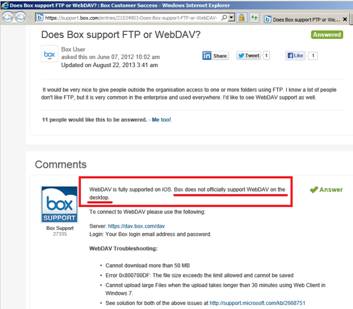
FTP is not supported for personal accounts; for business and enterprise accounts, it seems to be supported only for initial bulk data uploading. Box’s own support explicitly mentioned that “we don’t recommend using FTP as your primary access method.” In our testing, Box’s FTP service is far from robust. It cannot even resume uploading a large file.
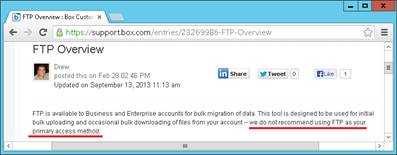
Besides, using FTP negates almost all Box.com’s main advantages. Why would a customer pay $180/year/user for a plain FTP hosting service?
3.10 Box lacks enterprise scalability
Box touts that many Fortune 500 companies use its service. However, it is interesting to note that in 2011, Average Box users (incl. paid members) only have 43 files. Assuming each document file is about 2MB, then on average, each user uses only 86MB of storage space! The service might be reasonable for light use, but it does not scale well to true enterprises.
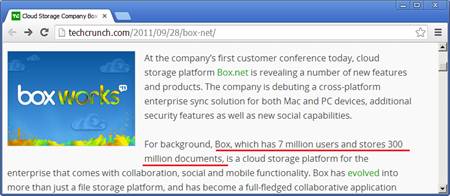
3.10.1 The max file size is quite small even with Box's paid service
Free users are limited to only 250MB, a paid personal account is limited to only 1GB; business accounts are limited to only 2GB, even the enterprise account is limited to only 5GB. We are puzzled how this can work. Most enterprises have much larger files, e.g. Outlook PST files, Database files, VHD files and video files that can be as large as 10GB to 200GB.
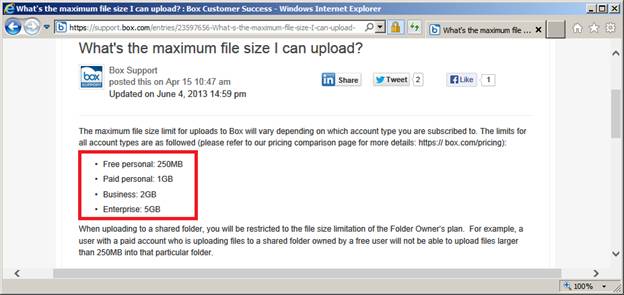
3.10.2 Box can only support 15,000 items per folder level for Copy / Move
Box recently announced that they have improved their folder copy/move speed. See the message and the screenshot below: "Updated recommended limits We recently upgraded our move/copy speed, resulting in a raised recommended maximum folder size from 10,000 items per level to 15,000 items per level. We have also raised our total tree move size from 20,000 items to 100,000 items."
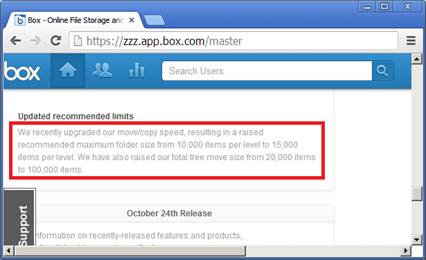
If it is designed for enterprise, why there is a limit in the first place?
3.10.3 Active Directory integration is offered through a 3rd party at additional cost
Box uses Onelogin's service for Active Directory integration. Onelogin service is not completely free. It charges $5/user/month for enterprise customers!
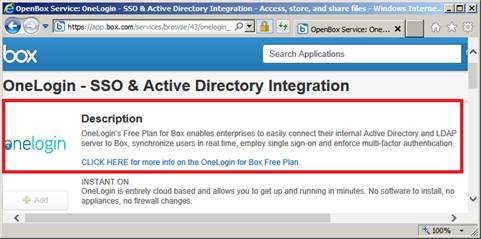
Involving a 3rd party company for such important account security feature may increase the security risks and affect the system reliability as the 3rd party service’s security and reliability will also affect Box’s service. DriveHQ natively supports Active Directory integration and SSO.
3.10.4 Box service cannot scale to other enterprise cloud services
Box does not support other cloud features such as automatic online backup, email hosting, web hosting and email backup, true drop box folder, and it only offers limited WebDAV drive mapping and FTP hosting services. Enterprises often need more than just one cloud services. If they need more than cloud storage and sharing service, they would have to sign up for a different service from a different vendor. DriveHQ offers a one-stop shop for all core IT services.
4. See what other experts are saying
4.1 The TechReviewer editor Colt Agar gave Box 2/5 on function and 2.5/5 on features
The TechReviewer editor Colt Agar reviewed Box service on February 1, 2013. The screenshot is his review summary. As you can see, he gave Box 2/5 on function and 2.5/5 on features. In his review, Box's main selling point is the company reputation, which certainly has a lot to do with Box's marketing efforts. The detailed review is available at: http://thetechreviewer.com/service/box-personal-business-cloud-storage-review/
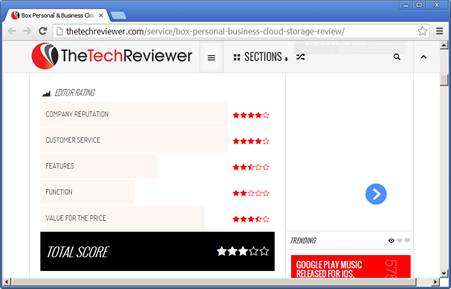
4.2 Anthony of CyberCompare.net reviewed Box and rated it 3 out of 5.
Anthony claims Box's service is great, but it does not bring anything new to the table. This is just a nice way of saying he is not impressed with Box’s services/features.
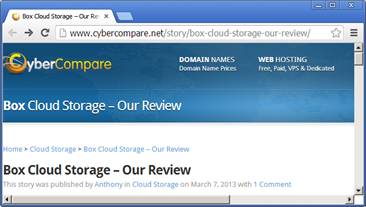

5. See what Box’s customers are saying.
Despite Box’s great reputation in the media, their users don’t seem to agree. Numerous customers reported severe problems with Box Sync on Box’s support forum. https://support.box.com/entries/21956033-box-sync-throttle e.g.: one user reported: Same thing here. I added about 440 Mb of files, and after that Box Sync has been working for about eight hours and is now up to 36.42%. It is sucking up 50% of my CPU, the fan is running at top speed, slowing my computer and network down to syrup. I'm worried that my CPU will fry..."
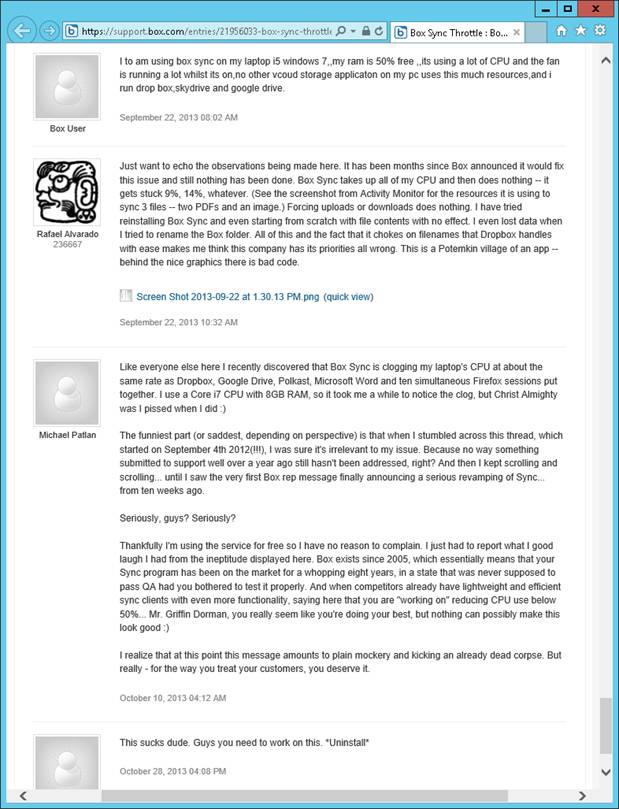
Also on Box's support forum, you can see more people are reporting problems with Box Sync: https://support.box.com/entries/22155812-box-sync-is-very-slow-almost-unusable A screenshot is attached below:
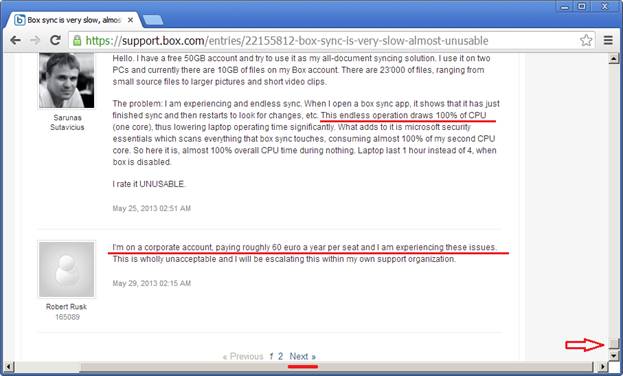
Appendices:
Comparison of DriveHQ FileManager and Box Sync
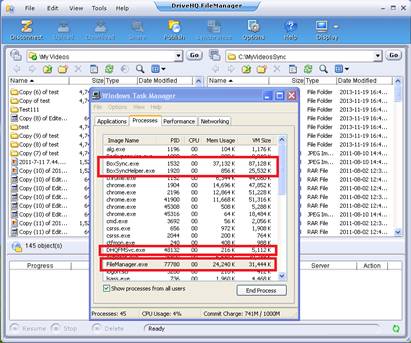 Memory usage when both FileManager and Box Sync are idle
Memory usage when both FileManager and Box Sync are idle
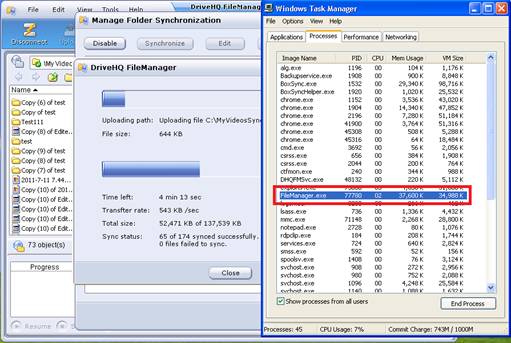 <
Memory usage when FileManager is synchronizing a folder.
<
Memory usage when FileManager is synchronizing a folder.
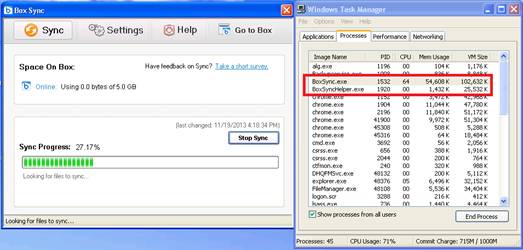 Memory usage when Box Sync is syncing a folder
Memory usage when Box Sync is syncing a folder

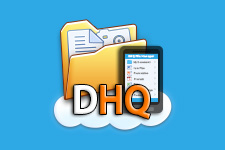











Leave a Comment